Dear Reader, in this age of AI created content, please support with your goodwill someone who works harder to provide the human-made. Sign up in the righthand column or bottom of this page. You will receive my hand illustrated monthly newsletter RESTORE NATURE and access to the biodiversity garden design course as I write...and nothing else, I respect your time.
The composting toilet
made & managed the easy low tech way
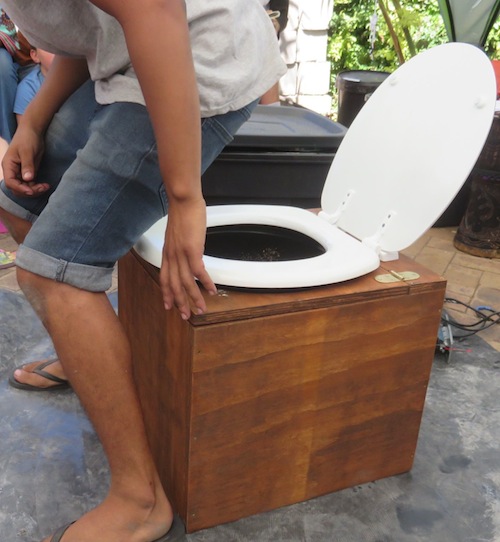 An easy to manage composting toilet design promoted worldwide by Joe Jenkins
An easy to manage composting toilet design promoted worldwide by Joe JenkinsGuerilla House have a new composting toilet workshop on how to build and manage a low tech humanure composting system.
I think the simplest most natural way that uses the resources in our toilet to the full, is the greenest, and the most elegant in terms of design, and this is the kind of technology we learned at the workshop.
There were four basic forms of compost toilet we were introduced to. The longdrop, the pit, the solar toilet, and the bucket system and composter combination.
Imraan was the workshop leader and as usual after researching thoroughly he had come up with clever shortcuts, or hacks, to make it easier for everyone else.
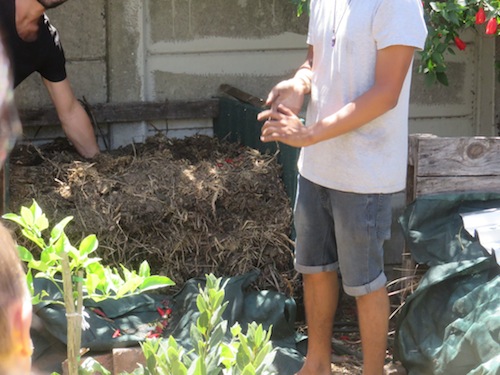 from commode to compost and fertility
from commode to compost and fertilityTrue elegance in a system
The following is a compilation of the information from the workshop and my own ideas on humanure composting.
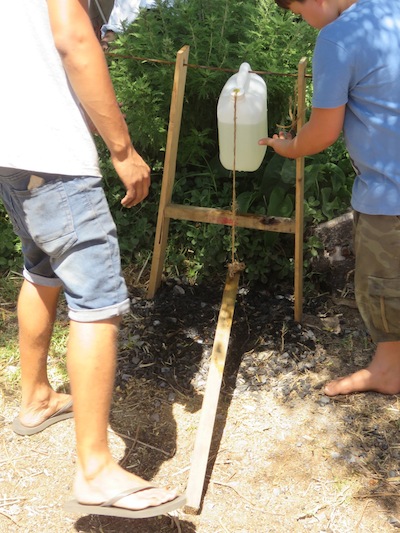 The foot operated Tippy tap for cleaning hands without touching the taps after working with humanure from your composting toilet
The foot operated Tippy tap for cleaning hands without touching the taps after working with humanure from your composting toiletThe long drop
Not much time was spent on introducing the long drop. Most of us in South Africa are already intimate. It is a pit in the earth, over which one positions oneself to defecate. This is globally the most widely spread toilet system, and is a composting toilet. Variation lies in the degree of structures built, from nothing at all beyond the pit, to boards one balances on and shielding surrounds, to a lovely brick outhouse as found in many old Goodwood houses. Advantages are no labour after building. The pit can be dug out, or the compost can just be left in the ground. In Africa's past tomatoes were grown in such trenches, and it sounds like a lovely example of closing cycles. Long drops in my memory, when visiting rural family, stank ferociously. They should not stink. Perhaps they did not add enough carbon material like sawdust, or deodorizer like ash.
The two chamber system
The two pit system requires very low maintenance only. It consists of a sealed but ventilated chamber with a chimney drawing air in from below, to ensure the kinder smelling and environmentally less polluting aerobic composting. One defecates and urinates into a hole at the top of the pit until it is full. Then the hole is closed and the one chamber of the composting toilet is left for a year and the second pit is used. After sufficient resting time, the compost is dug out and put on the farm or garden. This design normally necessitates a roofed outdoor toilet when retrofitting. The toilet must be raised above the pit, as the compost below must be dug out at some stage. It should be relatively easy to design into new houses especially on a slope. Its downside for myself is the sight of an immense mountain of turds and paper below, and look down you must, in order to avoid falling into the hole, and at worst breaking a leg.
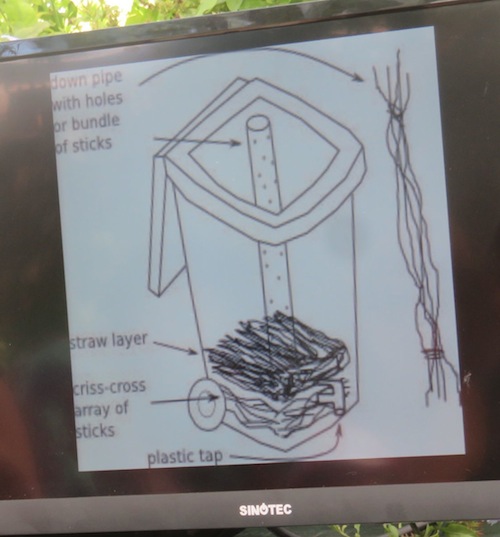 a wheelie bin composter we saw in a slide show at the workshop
a wheelie bin composter we saw in a slide show at the workshopThe solar system
The solar composting toilet involves a permanent structure too, much like the two-pit, except that the chamber has a sloping bottom, and most of this is roofed over with a glass roof, like a greenhouse. The glass traps heat and raises the temperature, and a combination of heat and thermophilic bacteria despatch the pathogens. The liquid drains off, the feces desiccate and eventually roll or shift slowly downwards where they are collected through a hatchway. The advantage of this system is that there is a constant flow through I guess, simplicity of structure. I have no idea how it smells. The disadvantage for me is the evaporation of ammonia and water, both precious resources.
The bucket and compost heap
The bucket system requires a comfortable seat above the bucket. I have sat on a bucket with no seat and its not only painful, but in my experience cross infection and UTI are a real risk, because the edge of the bucket gets touched by the feces and urine when you empty it. So the best for comfort and health is some kind of commode that houses the bucket. Sawdust, toilet paper and other carbon rich material are also added. If there is enough carbon there is no smell and the bucket can be kept in the bathroom till it is full. If the bucket rim is accessible, the lid can be placed back on it to prevent any flies getting at the compost.
When the bucket is full it can be closed with the lid pressed down tight and kept outside till you are ready to tend the compost pile.
Two easy to make commodes
We were shown how to build two types of commode at the workshop, a wooden box and a commode made of a plastic tote box which took about twenty minutes to build. In both cases the bucket rim sticks out of the box and supports the toilet seat of the normal shop variety. I’m much enamored of the tote-box version because its such a quick solution. Use the bucket to trace a line on the lid. Cut out the hole with a jigsaw, then drill holes for the screws and bolt a toilet seat to the lid.
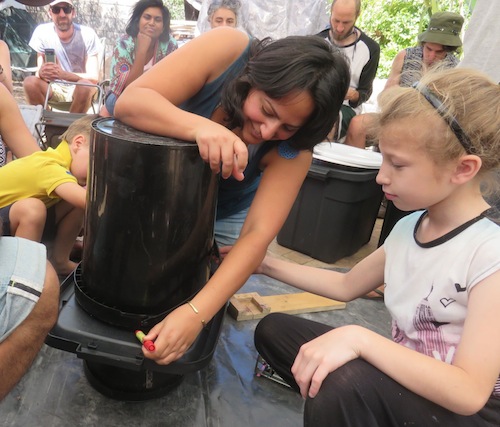 trace round bucket trace round bucket replace lid over bucket replace lid over bucket fasten seat fasten seat |
 saw along line saw along line drill holes for seat bolts drill holes for seat bolts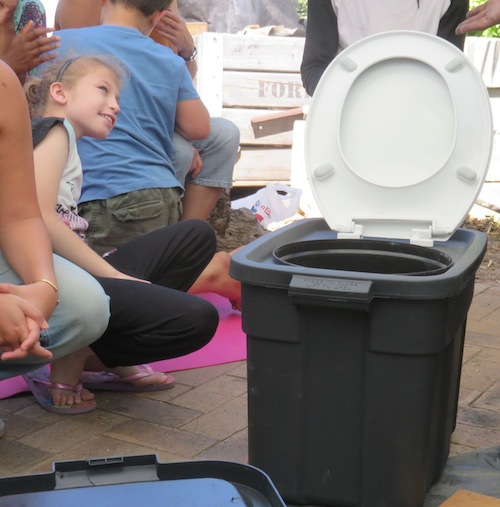 and there you have it and there you have it |
Composting the humanure
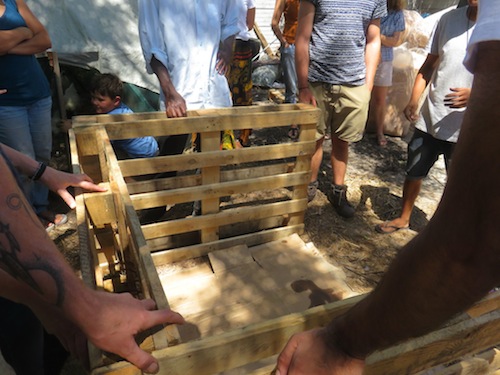 cardboard base
cardboard base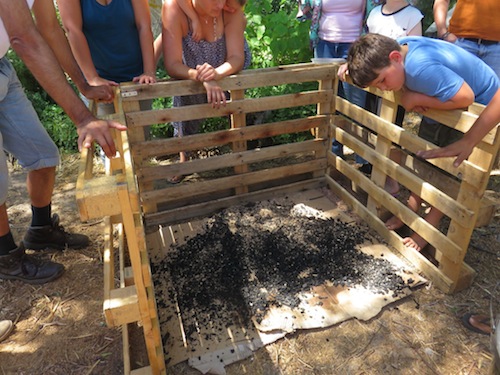 biochar optional
biochar optional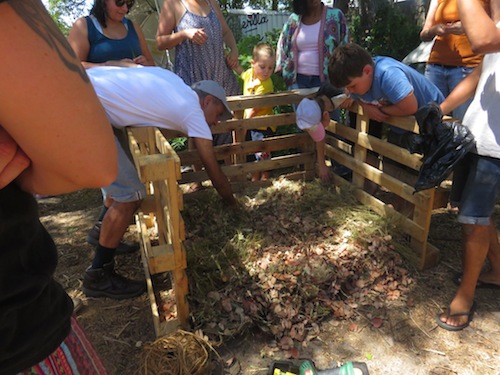 20cm garden waste
20cm garden wasteThe compost part of your composting toilet system need not be complex or hard work. In the composting heap, heat builds up because of the decay of the microbe food in the toilet waste, and the thick insulation of straw around it. You must always empty the bucket into the middle of the heap where it gets hottest, and don’t turn the heap like normal hot compost, as this would cause contaminated material to be moved to the outside where it is cool and pathogens will not be killed off so rapidly. After the heap is considered full or complete, replace the thick lid of straw and leave it alone for a year at least. After which it will be sweet smelling humus rich earth, and safe for humans.
Building a nice composting box
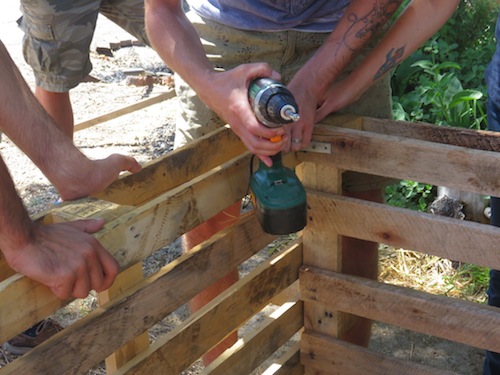 fasten edges together with L shaped metal angles
fasten edges together with L shaped metal anglesHaving a surround is purely for aesthetics and neatness of your compost pile. With enough space it really becomes superfluous. We learned to build a compost heap surround out of pallets screwed together with small metal angles. I use cable ties which are really quick, but my box looks a little drunk at the best of times. Pallets are ideal in size as a heap of a minimum of one cube is required to maintain the heat needed for the thermophilic bacteria, a quick way of making the compost safe. If you have space building a pentagonal rather than a square shape will massively increase the volume of the hot core of the composter.
Comparing the reduction of pathogens in the four composting toilet systems
In the solar composting toilet the heat supplied by the sun’s energy being trapped under glass nurtures thermophilic bacteria which destroy fecal pathogens. In a long drop and pit system heat can build up but the essential process is slow aerobic moldering, giving rise to a different population of microorganisms, with constant addition of new organism food to the heap. The killer of pathogens in these systems is time. They cannot survive for longer than a year outside our bodies. The long drop presents the danger, as it is open, dug in the earth, of pathogens contaminating ground water, especially if the water table is high, close to the latrine. In the hot composting system that accompanies the bucket system, both heat, thermophilic bacteria, and time come into play.
To separate or not to separate
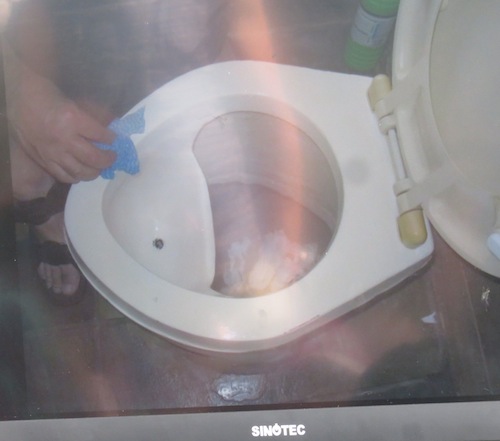 A commercial separator we saw in the slide show
A commercial separator we saw in the slide showHere we do separate, our ways part. There are the supporters of urine separation and those who compost the entire human output. My argument for separation is that urine is useful, and its sterile if separated early. The heap does not leak pathogens into the ground, if it is less wet, and the buckets are lighter and need less frequent toting. Disadvantages are cross infection from urine collectors that cause ‘splash back’, the additional expense and more complex technology of the separating system, the problem that urine salts clog small hoses used in the separation system, the problem of what to do with the copious amounts of urine and the loss of the necessary moisture and (maybe) nitrogen from the hot composting pile, though in my experience pure feces get hot enough. I have gone to great expense and trouble to build grow-beds that will use our urine output. Not everyone has the time or interest in such a system, and flat dwellers are logistically excluded. This separation idea is strictly within my own environment. If I'm going to be doing composting commercially, I will need to do it the way that my business partners find most appropriate and cost effective large scale which is whole output, unseparated.
Hi-tech composting toilets ?
We were shown some slides of various forms of composting toilet, from the sleek types found in hotels, with many moving parts, power assist and so forth. I think these overkill systems are inappropriate technology when simpler means do the job. An example of overkill is a toilet I've read about which has a rotating screw in a barrel several meters long extending from the toilet out backwards. First of all, it presents a problem of where to retrofit such a contraption in an old bathroom, and most of Cape Town needs retrofitting rather than building from scratch. Secondly its basic mechanism is desiccation of the poop, and evaporation of the urine’s ammonia. I have five objections here, first it is an environmental polluter, as by definition, all resources which are not recycled, are polluters, and it puts the toxic gas, ammonia, in the atmosphere. Secondly it wastes the valuable resource, hydrated ammonia, as a fertilizer and bleach. Thirdly it evaporates off the water, our scarcest resource, and fourthly it kills the useful microorganisms in the poop delivering a dead substance rather than rich environment enhancing soil improving compost. What is the point of the composting toilet that doesn't make compost. Last of all, its price and need for rebuilding the bathroom entirely makes it out of reach for most Capetonians. It’s a so called composting toilet, but really green ? not in my humble opinion, and people care as in Permaculture’s principles… I don’t think so. Their necessity beyond the hospitality industry remains doubtful.
I attended the first Guerilla House workshop on composting toilets last weekend, thanks to Riyaaz Ismail’s sponsorship. Riyaaz is going places as a developer of green technology. He is a student of disaster management at the University of Stellenbosch, and has a profound interest in finding solutions for the City of Cape Town's problems.
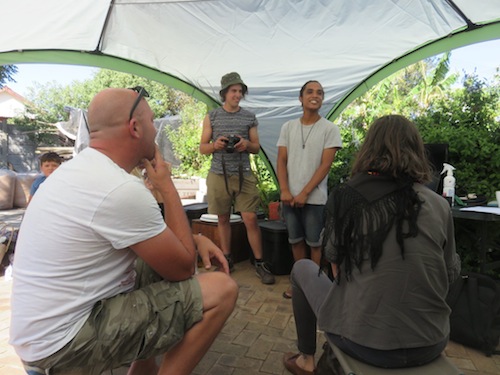 Imraan and Josh entertaining the composting toilet fans
Imraan and Josh entertaining the composting toilet fansThe genius of Guerilla House
Guerilla House supports the free exchange of information through the ‘commons’ as a guiding principle, yet sometimes I feel that processing information is something they do so well and what they teach is so necessary, they should be paid more for it.
I wish they could be rewarded for the skill and hard work invested in their numerous inventions. No inventor with a patent created anything de novo, they are all improvements. The genius of permaculture technology in South Africa shines in the partnership of Imraan and Josh of Guerilla House.
Closing cycles
 Our beautiful lunch
Our beautiful lunchThis was a really good workshop as usual and I recommend taking part if you see any other workshops on the composting toilet coming up. We closed with a bring along lunch which will hopefully end up as nutritiously diverse compost heap fuel and it was totally delicious. Thank you Guerilla House for doing the right thing at the right time.
------
home page for lots of links to information on easy natural gardening
------
------
a pentagonal composter with a lot more effective composting volume
------
The Humanure Handbook, Joe Jenkins, 2005.
your questions about composting
Do you have any questions about composting ? This is the place to interact with us. Please enter your questions here.
What Other Visitors Have Said
Click below to see contributions from other visitors to this page...
Eco Long Drop Pit Latrines Uganda 




Good evening from the UK.
My name is Murray Kirkham and I am the chairman of the International and foundation committee of my local Lindum Lincoln …
What not to compost? 




Hello Caroline,
thank you for your very informative article about the subject of compost toilets. I always enjoy the topics you cover on Greenidiom.com. …
Restore Nature Newsletter
I've been writing for four years now and I would love to hear from you
Please let me know if you have any questions, comments or stories to share on gardening, permaculture, regenerative agriculture, food forests, natural gardening, do nothing gardening, observations about pests and diseases, foraging, dealing with and using weeds constructively, composting and going offgrid.
SEARCH
Order the Kindle E-book for the SPECIAL PRICE of only
Prices valid till 30.09.2023
Recent Articles
-
Geography Research Task
Jan 31, 25 11:37 PM
To whom it may concern My name is Tanyaradzwa Madziwa and I am a matric student at Springfield Convent School. As part of our geography syllabus for this -
Eco Long Drop Pit Latrines Uganda
Nov 29, 24 02:45 AM
Good evening from the UK. My name is Murray Kirkham and I am the chairman of the International and foundation committee of my local Lindum Lincoln Rotary -
Landscape Architect
Oct 01, 24 10:42 AM
I so appreciate your informative description! Your experimentation and curiosity with the seeds, germination, and rearing of the maggot are exciting to
"How to start a profitable worm business on a shoestring budget
Order a printed copy from "Amazon" at the SPECIAL PRICE of only
or a digital version from the "Kindle" store at the SPECIAL PRICE of only
Prices valid till 30.09.2023





